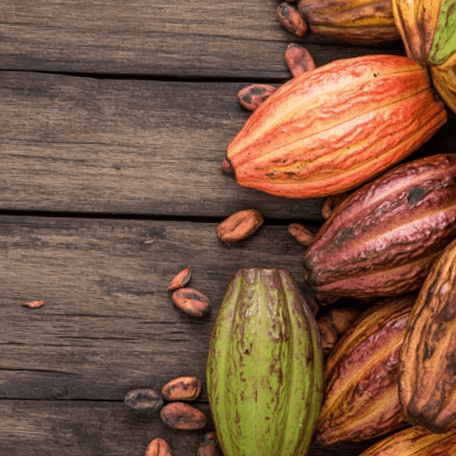Climate change and, specifically, severe weather events have seen global cocoa prices soar to almost $10,000 a tonne this month – setting the scene for an expensive Easter for confectionary fans.
In early March we posted our Chart of the Month, which highlighted that global cocoa prices had jumped to record levels of around $6,500 a tonne. Yet in the two weeks since, cocoa futures in New York have surged a further 50% to nearly $10,000 – a near tripling in prices over the last year alone.
The primary cause of rocketing prices is the increased incidence of extreme weather events. Long-term climate change has been exacerbated in the last couple of years by the periodic El Niño phenomenon in which rising sea surface temperatures affect weather patterns.
Around two-thirds of the world’s cocoa crop is supplied by West African countries including Ivory Coast and Ghana. Last year, this region was hit by unusually heavy rainfall that created conditions in which black pod disease ravaged cocoa crops. This year, it has endured unseasonably hot and dry conditions that have depressed yields.
Compounding this disrupted supply picture is the fact that demand is steadily on the rise. The International Cocoa Organization’s latest forecasts (February 2024) for 2024 include a 374,000 tonne deficit between global production and demand for cocoa ‘grindings’ to make chocolate.
While confectionary companies were partly insulated from cocoa price rises in 2023 due to stockpiles and fixed-price contracts, they are now increasingly exposed to this rising raw material cost. In our Chart of the Month, we speculated that this year’s Easter eggs are likely to cost more as manufacturers protect profits, or perhaps trend towards mini-eggs as shrinkflation takes hold.
A report last week[1] from consumer advice group Which? confirmed things do indeed look tough for chocoholics this year. It found that chocolate prices are 12.6% higher than a year ago, with the worst offenders in terms of easter egg inflation including the Maltesers Truffles Luxury Easter Egg (up 62% to £13 at Waitrose) and the Ferrero Rocher Golden Easter Egg (up 50% to £15 at Tesco).
Which? also found evidence of easter egg shrinkflation as an alternative way of confectionary companies dealing with higher costs. The Mars Milk Chocolate ‘large’ egg is now 201g rather than 252g while the Smarties Orange Chocolate egg has shrunk from 226g to 188g.
While easter eggs may seem a luxury that many of us can reluctantly cut back on this year, the cocoa price rise is just one example of the hugely significant impact that climate change will have on agriculture.
Global warming is affecting temperatures and rain patterns globally, with the geographic areas that can sustain particular crops set to shift from their traditional homes and – in many cases – shrink. This will clearly have an impact on people living and working in areas threatened by displacement, as well as for consumers globally.
With over half the UK population drinking coffee at least once a day, shifting weather patterns in South America, Africa and Asia are likely to hit home over the next few decades. The Economist recently reported on academic studies showing around 50% of the world’s current coffee-growing land will be unsuitable by 2050.
Meanwhile, the Intergovernmental Panel on Climate Change (IPCC) last year warned that we are on track to exceed the 1.5C target for global warming (versus pre-industrial levels) by the 2030s, with the 2C limit also looking threatened. The impact on food systems is just one of the ways in which climate change is affecting the global economy and population, emphasising that the impetus to tackle greenhouse gas emissions should be greater than ever.
For over 20 years, Liontrust’s Sustainable Investment team has been investing in companies that are aligned with reducing greenhouse gas emissions. They believe there is a huge investment opportunity from the growth of businesses which are providing the solutions to this problem.
For examples of companies the team sees as essential to decarbonisation, read their recent blog: Investing in companies that will drive decarbonisation | Insights | Liontrust Asset Management PLC
[1] https://www.which.co.uk/news/article/easter-eggs-soar-in-price-aScks3N8LN0C
KEY RISKS
Past performance is not a guide to future performance. The value of an investment and the income generated from it can fall as well as rise and is not guaranteed. You may get back less than you originally invested.
The issue of units/shares in Liontrust Funds may be subject to an initial charge, which will have an impact on the realisable value of the investment, particularly in the short term. Investments should always be considered as long term.
The Funds managed by the Sustainable Future Team:
Are expected to conform to our social and environmental criteria. May hold overseas investments that may carry a higher currency risk. They are valued by reference to their local currency which may move up or down when compared to the currency of a Fund. May hold Bonds. Bonds are affected by changes in interest rates and their value and the income they generate can rise or fall as a result; The creditworthiness of a bond issuer may also affect that bond's value. Bonds that produce a higher level of income usually also carry greater risk as such bond issuers may have difficulty in paying their debts. The value of a bond would be significantly affected if the issuer either refused to pay or was unable to pay. May encounter liquidity constraints from time to time. The spread between the price you buy and sell shares will reflect the less liquid nature of the underlying holdings. May invest in companies listed on the Alternative Investment Market (AIM) which is primarily for emerging or smaller companies. The rules are less demanding than those of the official List of the London Stock Exchange and therefore companies listed on AIM may carry a greater risk than a company with a full listing. May invest in smaller companies and may invest a small proportion (less than 10%) of the Fund in unlisted securities. There may be liquidity constraints in these securities from time to time, i.e. in certain circumstances, the fund may not be able to sell a position for full value or at all in the short term. This may affect performance and could cause the fund to defer or suspend redemptions of its shares. May, under certain circumstances, invest in derivatives, but it is not intended that their use will materially affect volatility. Derivatives are used to protect against currencies, credit and interest rate moves or for investment purposes. There is a risk that losses could be made on derivative positions or that the counterparties could fail to complete on transactions. The use of derivatives may create leverage or gearing resulting in potentially greater volatility or fluctuations in the net asset value of the Fund. A relatively small movement in the value of a derivative's underlying investment may have a larger impact, positive or negative, on the value of a fund than if the underlying investment was held instead. The use of derivative contracts may help us to control Fund volatility in both up and down markets by hedging against the general market. The use of derivative instruments that may result in higher cash levels. Cash may be deposited with several credit counterparties (e.g. international banks) or in short-dated bonds. A credit risk arises should one or more of these counterparties be unable to return the deposited cash. Outside of normal conditions, may hold higher levels of cash which may be deposited with several credit counterparties (e.g. international banks). A credit risk arises should one or more of these counterparties be unable to return the deposited cash. May be exposed to Counterparty Risk: any derivative contract, including FX hedging, may be at risk if the counterparty fails. Do not guarantee a level of income.
The risks detailed above are reflective of the full range of Funds managed by the Sustainable Future Team and not all of the risks listed are applicable to each individual Fund. For the risks associated with an individual Fund, please refer to its Key Investor Information Document (KIID)/PRIIP KID.
DISCLAIMER
This is a marketing communication. Before making an investment, you should read the relevant Prospectus and the Key Investor Information Document (KIID), which provide full product details including investment charges and risks. These documents can be obtained, free of charge, from www.liontrust.co.uk or direct from Liontrust. Always research your own investments. If you are not a professional investor please consult a regulated financial adviser regarding the suitability of such an investment for you and your personal circumstances.
This should not be construed as advice for investment in any product or security mentioned, an offer to buy or sell units/shares of Funds mentioned, or a solicitation to purchase securities in any company or investment product. Examples of stocks are provided for general information only to demonstrate our investment philosophy. The investment being promoted is for units in a fund, not directly in the underlying assets. It contains information and analysis that is believed to be accurate at the time of publication, but is subject to change without notice. Whilst care has been taken in compiling the content of this document, no representation or warranty, express or implied, is made by Liontrust as to its accuracy or completeness, including for external sources (which may have been used) which have not been verified.







